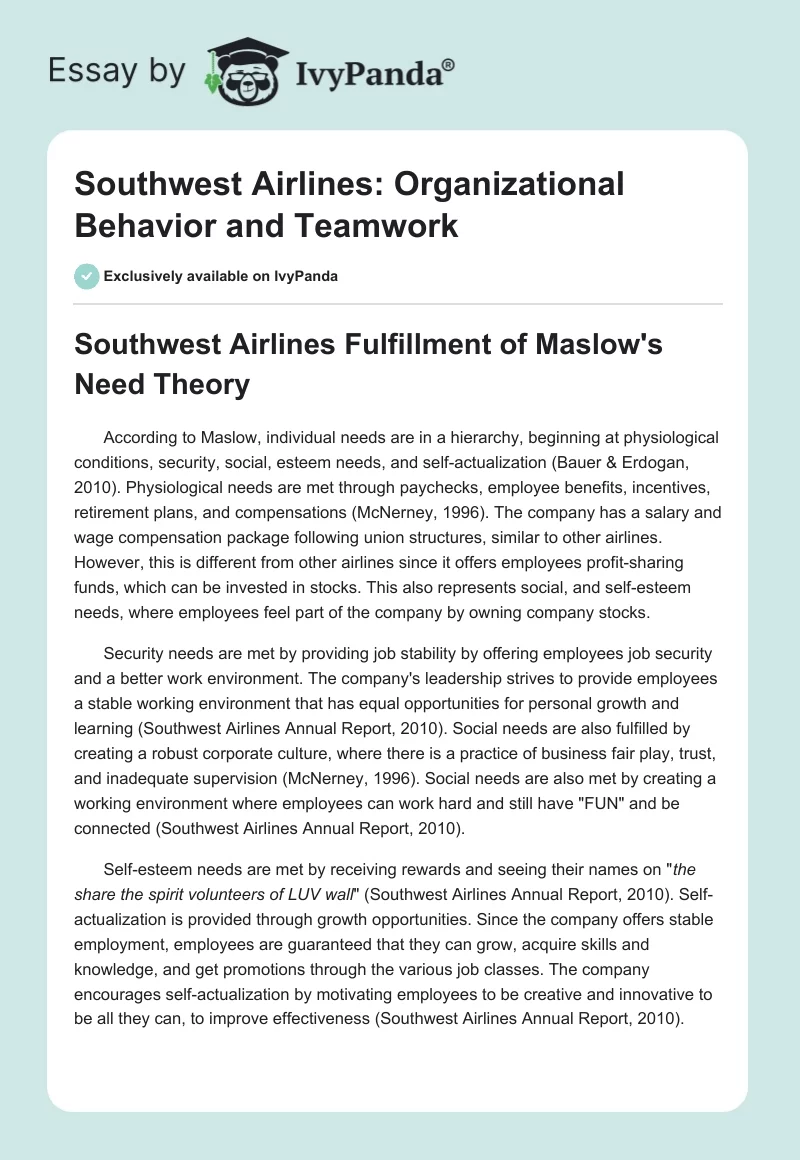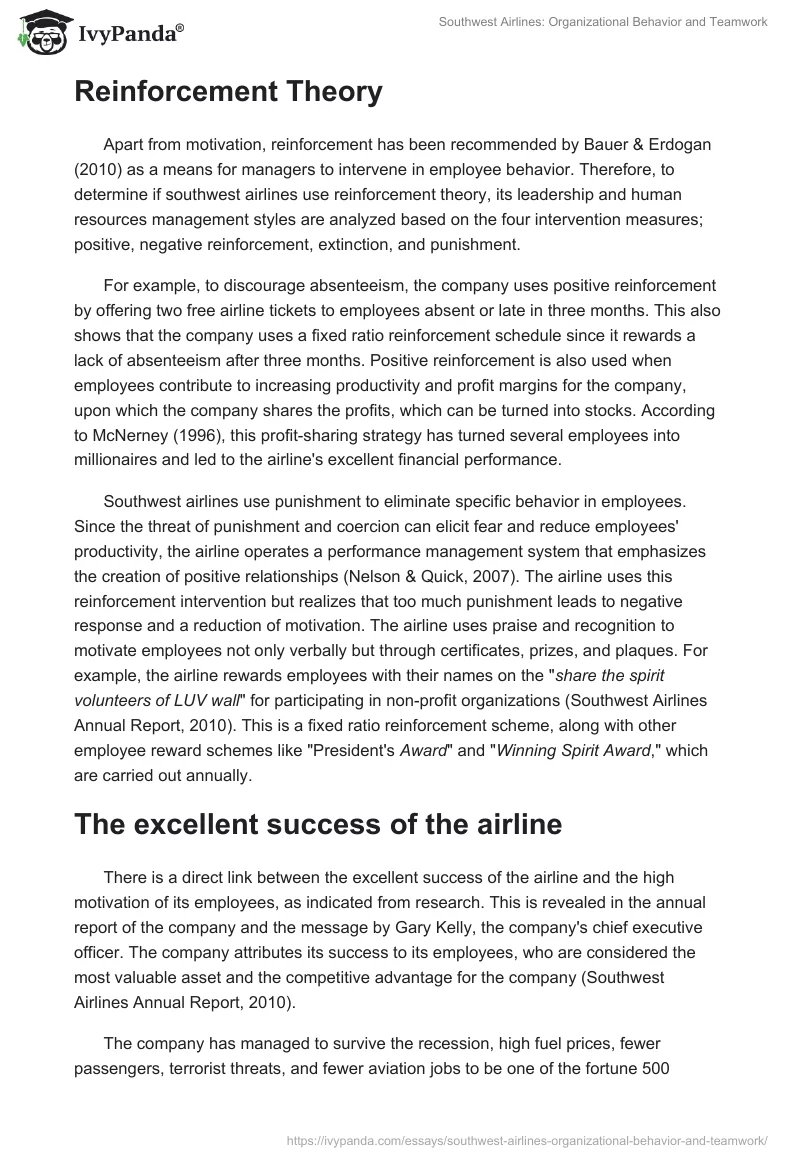Southwest Airlines Fulfillment of Maslow’s Need Theory
According to Maslow, individual needs are in a hierarchy, beginning at physiological conditions, security, social, esteem needs, and self-actualization (Bauer & Erdogan, 2010). Physiological needs are met through paychecks, employee benefits, incentives, retirement plans, and compensations (McNerney, 1996). The company has a salary and wage compensation package following union structures, similar to other airlines. However, this is different from other airlines since it offers employees profit-sharing funds, which can be invested in stocks. This also represents social, and self-esteem needs, where employees feel part of the company by owning company stocks.
Security needs are met by providing job stability by offering employees job security and a better work environment. The company’s leadership strives to provide employees a stable working environment that has equal opportunities for personal growth and learning (Southwest Airlines Annual Report, 2010). Social needs are also fulfilled by creating a robust corporate culture, where there is a practice of business fair play, trust, and inadequate supervision (McNerney, 1996). Social needs are also met by creating a working environment where employees can work hard and still have “FUN” and be connected (Southwest Airlines Annual Report, 2010).
Self-esteem needs are met by receiving rewards and seeing their names on “the share the spirit volunteers of LUV wall” (Southwest Airlines Annual Report, 2010). Self-actualization is provided through growth opportunities. Since the company offers stable employment, employees are guaranteed that they can grow, acquire skills and knowledge, and get promotions through the various job classes. The company encourages self-actualization by motivating employees to be creative and innovative to be all they can, to improve effectiveness (Southwest Airlines Annual Report, 2010).
Reinforcement Theory
Apart from motivation, reinforcement has been recommended by Bauer & Erdogan (2010) as a means for managers to intervene in employee behavior. Therefore, to determine if southwest airlines use reinforcement theory, its leadership and human resources management styles are analyzed based on the four intervention measures; positive, negative reinforcement, extinction, and punishment.
For example, to discourage absenteeism, the company uses positive reinforcement by offering two free airline tickets to employees absent or late in three months. This also shows that the company uses a fixed ratio reinforcement schedule since it rewards a lack of absenteeism after three months. Positive reinforcement is also used when employees contribute to increasing productivity and profit margins for the company, upon which the company shares the profits, which can be turned into stocks. According to McNerney (1996), this profit-sharing strategy has turned several employees into millionaires and led to the airline’s excellent financial performance.
Southwest airlines use punishment to eliminate specific behavior in employees. Since the threat of punishment and coercion can elicit fear and reduce employees’ productivity, the airline operates a performance management system that emphasizes the creation of positive relationships (Nelson & Quick, 2007). The airline uses this reinforcement intervention but realizes that too much punishment leads to negative response and a reduction of motivation. The airline uses praise and recognition to motivate employees not only verbally but through certificates, prizes, and plaques. For example, the airline rewards employees with their names on the “share the spirit volunteers of LUV wall” for participating in non-profit organizations (Southwest Airlines Annual Report, 2010). This is a fixed ratio reinforcement scheme, along with other employee reward schemes like “President’s Award” and “Winning Spirit Award,” which are carried out annually.
The excellent success of the airline
There is a direct link between the excellent success of the airline and the high motivation of its employees, as indicated from research. This is revealed in the annual report of the company and the message by Gary Kelly, the company’s chief executive officer. The company attributes its success to its employees, who are considered the most valuable asset and the competitive advantage for the company (Southwest Airlines Annual Report, 2010).
The company has managed to survive the recession, high fuel prices, fewer passengers, terrorist threats, and fewer aviation jobs to be one of the fortune 500 companies. This was made possible through their passion and focus on “performance, people, and the planet.”
The company’s passion is directed at creating a family culture where its 35,000 employees are encouraged to be creative, innovative through programs that increase productivity, develop new ideas to cut back costs, and give back to the planet and community (Southwest Airlines Annual Report, 2010). The company strives to increase productivity by highly motivating these employees through the provision of a stable working environment, equal opportunity for personal growth and learning through its “University for People,” “Manager in Training Program,” and “Onboarding” program for new recruits (Southwest Airlines Annual Report, 2010).
Additionally, this strategy has been heightened by the company’s plan to create a citizenship team, which identifies performance indicators. One of the key performance indicators is the increment of employee involvement.
Therefore, by encouraging creativity and innovation, the airline realizes higher productivity through its employees. Moreover, programs that encourage personal growth and learning allow employees to develop skills and knowledge that increase productivity through new experience that has enabled them to survive the recession. Since the company a given deep concern, respect, and a caring attitude, they reflect it in their work and service to customers, who make Southwest Airlines a preferred domestic airline.
References
Bauer, T., and Erdogan, B. (2010). Organizational Behavior. Web.
McNerney, D. Jr. (1996). Creating a Motivated Workforce. New York: H.R. Focus. Web.
Nelson, D.L., and Quick, J.C. (2007). Understanding Organizational Behavior. Canada: Thomson South-Western.
Southwest Airlines Inc. (2010). Annual Report. Southwest.com. Web.


